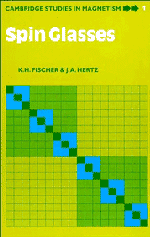Book contents
- Frontmatter
- Contents
- Preface
- 1 Introduction
- 2 Models, order parameters, and systems
- 3 Mean field theory I: Ising model, equilibrium theory
- 4 Introduction to dynamics
- 5 Mean field theory II: Ising dynamics
- 6 Mean field theory III: vector spins
- 7 Short-range interactions: low-temperature properties
- 8 Beyond mean field theory
- 9 Dynamics on many time scales
- 10 Specific heat, sound propagation, and transport properties
- 11 Competition between spin glass and ferromagnetic or antiferromagnetic order
- 12 One-dimensional models
- 13 Random field and random anisotropy
- 14 The physics of complexity
- 15 A short history of spin glasses
- References
- Index
13 - Random field and random anisotropy
Published online by Cambridge University Press: 01 June 2011
- Frontmatter
- Contents
- Preface
- 1 Introduction
- 2 Models, order parameters, and systems
- 3 Mean field theory I: Ising model, equilibrium theory
- 4 Introduction to dynamics
- 5 Mean field theory II: Ising dynamics
- 6 Mean field theory III: vector spins
- 7 Short-range interactions: low-temperature properties
- 8 Beyond mean field theory
- 9 Dynamics on many time scales
- 10 Specific heat, sound propagation, and transport properties
- 11 Competition between spin glass and ferromagnetic or antiferromagnetic order
- 12 One-dimensional models
- 13 Random field and random anisotropy
- 14 The physics of complexity
- 15 A short history of spin glasses
- References
- Index
Summary
In most of this book the important randomness we were concerned with was random exchange. In this chapter we will examine systems characterized by two other kinds of randomness: random external fields and random anisotropy. They both share some general features with random exchange, but they have different properties as well. They also differ significantly from each other.
We studied random anisotropy, especially of the Dzyaloshinskii–Moriya sort, in Chapter 6, and again, briefly, in Chapter 7. However, there we were interested in it as a small perturbation on a system whose physics was determined primarily by random exchange. Its importance lay in the fact that it changed the overall symmetry of the system, and this had qualitative consequences at long lengthscales.
A similar remark applies to random fields: Whenever we have been interested in the effects of uniform external fields (as in the AT line, for example) they might as well have been random fields; for symmetrically distributed exchange interactions, the only condition on the external field was that it be uncorrelated with the interactions. Thus we could say that we have implicitly been studying the effects of random fields in spin glasses, but, as with the random anisotropies we studied, we were mainly interested in their effects as perturbations on the spin glass state produced by the random exchange.
Both these kinds of randomness are local, so they only produce trivial behaviour by themselves.
Information
- Type
- Chapter
- Information
- Spin Glasses , pp. 337 - 354Publisher: Cambridge University PressPrint publication year: 1991
